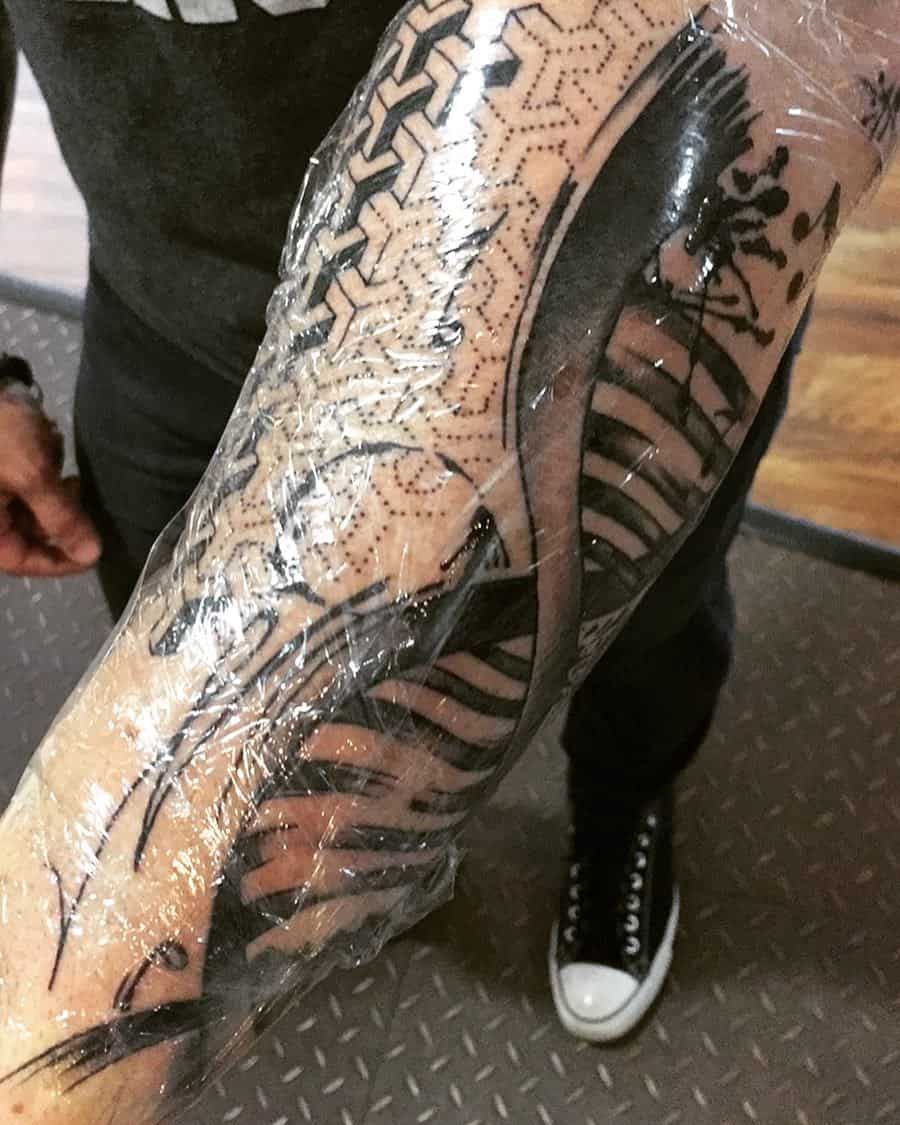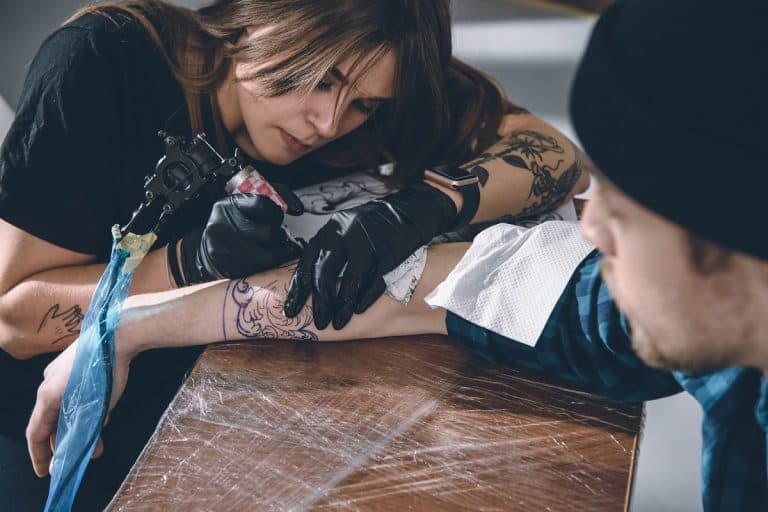Tattoo Wrapping: Can I Wrap The Tattoo In Cling Film, and For How Long?
Tattoo wrapping seems to be ubiquitous around the world. Professional tattoo artists wrap a new tattoo with different types of wrappings to protect it and ensure it stops oozing and bleeding faster.
However, since the wrapping methods vary, we cannot help but wonder which wrapping method is the best, and how long can a tattoo really stay wrapped?
If you’ve just arrived home from a tattoo appointment, chances are your tattoo is wrapped in cling film. So, let’s start by discussing this topic at hand, and then we’ll tackle other wrapping information and recommendation for your future tattoo endeavors.
Tattoo Wrapping: 7 Things You Need to Know

1. Why Do Tattooists Wrap New Tattoos?
Generally speaking, tattooists wrap new tattoos for a few important reasons;
- To ensure the tattoo stops bleeding and oozing faster
- To protect the tattoo from external, infection-causing factors
- To help you not mess up your clothes, furniture, and bedding until the tattoo stops bleeding
Even though the reasons for tattoo wrapping are completely valid and helpful, the notion of tattoo wrapping is still one of the most debated topics in the tattoo community. Apparently, some tattoo artists don’t find tattoo wrapping necessary, while others can’t imagine not wrapping a new tattoo.
So, if you come across a tattoo artist that doesn’t, for some reason wrap tattoos, make sure to still ask them to wrap your tattoo. You don’t want to go home with bloody clothes sticking to your new tattoo. Nor do you want to transfer bacteria and germs to the tattoo and cause an infection.
Under certain legislation, the majority of countries require a new tattoo to be wrapped in a sterile bandage to prevent infection, so keep that in mind as well.
2. What Are The Benefits of Wrapping a Tattoo?
As we mentioned, one of the main reasons, and benefits as well, of wrapping a tattoo is the fact that there is something to protect a tattoo or a ‘fresh wound’ from bacteria, viruses, and germs. However, some of the benefits also include;
- The wrap creates a barrier between the tattoo and the potential external infections caused by bacteria, germs, viruses, etc.
- The wrap controls the bleeding and oozing, allowing you to go on with your life, mess-free.
- The wrap allows you to sleep properly, without messing up your clothes and bedding or having the bedding stick to your tattoo.
- The wrap protects your tattoo from external physical impact, for example, during contact sports, or other physical activities (which you should minimize, by the way, until the tattoo heals).
- The wrap protects your tattoo in case you need to wear tight-fitting clothes or clothes made from potentially irritating fabrics.
- In case you move in a potentially dirty and unsanitized environment during your tattoo healing, re-rapping the tattoo could protect it from potential infections.
3. Okay, But Why Do Tattooists Wrap Tattoos In Cling Film?
The origin of the practice of wrapping tattoos in cling film is allegedly the biker gangs from the ’60s and ’70s. The reason they wrapped their tattoos in cling film is pretty straightforward and silly; they wanted their tattoos to be visible even though they’re fresh, bleeding, and oozing.
Cling film is seethrough, and when covered, it keeps the blood and excess ink more tamed and not as excessive and messy and it would usually be without the cling film. Plus, the tattoo would be visible, and partially protected from external infections.
The practice continued in the decades to come, but nowadays, cling film wrapping is not as popular as it was before. There is a heated discussion about whether tattooists should wrap tattoos with plastic wraps, but that depends on the tattoo artist and their preferred methods.
4. How Long Should I Keep a Tattoo Wrapped In Cling Film?
The time you should keep your tattoo wrapped with cling film also depends on what your tattoo artist thinks is appropriate. Some tattoo artists recommend you keep the tattoo wrapped between 2 and 4 hours, others recommend you keep the tattoo wrapped overnight. However, this is a bit more complicated.
The time your tattoo required to be wrapped depends on the heaviness of bleeding and oozing, and the activities you’re doing in the meantime. For example, if your tattoo is fresh and heavily bleeding, you should take off the cling film and wash the tattoo. After that, you should not re-wrap the tattoo, unless you’re going to sleep or wearing tighter clothes.
Either way, make sure to follow your tattoo artist’s aftercare routine recommendations. Each tattoo situation is unique and the aftercare depends on the type of the tattoo, size, and placement, as well as the preferences and practices of the particular tattoo artists.
Here are some of the general recommendations when it comes to tattoo wrapping duration;
- After you get a tattoo, make sure to keep it wrapped for 2 to 4 hours before cleaning it. After you clean the tattoo, tap dries it with a paper towel, and do not re-wrap it until you got to sleep.
- Keep the tattoo wrapped during sleep for 3 to 5 days. In that period, the tattoo should start to dry out and close, so there won’t be any risk of sudden bleeding or bedding sticking to your tattoo as you sleep.
- Once the tattoo is closed or sealed completely, there is no need for re-wrapping. Just keep the tattoo clean and properly moisturized, and you should be fine.
Also Read: How To Sleep With A New Tattoo: 8 Tips From Expert
5. Should You Re-Wrap Your Tattoo With Cling Film?
Some tattoo artists will say that you can use cling film or plastic foil to re-wrap your new tattoo. However, this is also highly debatable. Many think that tattoos wouldn’t be wrapped with plastic foils in the first place, while others believe the re-wrapping should be done with something medical-grade, like wrappings that are specifically made for tattoos with proper hygiene and sanitation.
So, instead of re-wrapping your tattoo with cling film, we recommend you go for;
TattooMed’s tattoo protection film – this is a waterproof, breathable protection film or bandage specifically made for tattoos. Also known as the ‘second skin’ tattoo bandage, this film will ensure proper tattoo protection, and breathability, so your tattoo dries naturally and starts healing without any delay or issues.
It is generally recommended to re-wrap a new tattoo with a sterile bandage or a cheese/muslin cloth to keep the tattoo protected and mess-free in the first 24 hours. Cling film should be used as a last resort, due to the possible issues with hygiene and cling film potentially not being sterile or causing infection.
6. Why Should I Avoid Cling Film Tattoo Wrapping?
As many tattoo artists say, cling film is the last resort to tattoo wrapping and it should be avoided. Cling film is good for tattoo wrapping right after the tattoo is done; once you remove the cling film, in the following 2 to 4 hours, you should not use it to re-wrap the tattoo.
Now, the reason for this lies in the fact that cling film is made from plastic. The plastic is not a breathable material, so it traps the air in the tattoo, preventing it from naturally drying out and healing. Without drying out, the tattoo cannot close and seal.
Not to mention that the plastic wrap created a tattoo vacuum, which can heat up the tattooed skin, promoting quicker bacteria and germ breeding and growth.
There were also cases of tattoo blowout being caused by cling film and plastic tattoo wraps. Such cases were also accompanied by infections caused by the perpetual moistness of the tattoo since it couldn’t dry out under the plastic wrap.
7. How Can I Re-Wrap a Tattoo On My Own?
The first tattoo wrapping is done by your tattoo artist. But, what happens when you want to re-wrap the tattoo at home? How can you do it on your own? Here are some tips and tricks to utilize for this situation;
- Make sure you’re in a clean and sterile environment; find the cleanest room in your home, and if you cannot recreate the cleanliness of a tattoo studio, then you may not want to re-wrap the tattoo at home.
- Make sure to wash your hands thoroughly before touching the tattoo. Use at least 60% alcohol hand-washing soap, and wash your hands for at least 20 seconds. Focus on the fingers, the nail, and they are between the fingers as well. After you wash your hands, make sure not to touch anything else other than the tattoo.
- Wash the tattoo with lukewarm water and antibacterial, gentle, and fragrance-free soap. After you wash the tattoo, tap dry it with a paper towel or let it air-dry on its own.
- Now that the tattoo is cleaned and dried, take the breathable wrap and apply it carefully onto the tattoo. Make sure the wrap covers the whole tattoo, and ensure the adhesive ends up sticking to the skin surrounding the tattoo, not the tattooed skin.
Make sure to keep the tattoo re-wrapped for a few hours, or overnight. After you remove the wrap again, you will need to wash and dry your tattoo again. Refrain from leaving the wrap on for several days, as some manufacturers advise, without consulting your tattooist first.
Final Thoughts
When it comes to tattoo wrapping, the best thing you can do is follow your tattoo artist’s recommendations. Regarding the cling film tattoo re-wrapping, we strongly recommend you go for other, sterile, and more medical-grade wrapping options to prevent any potential health issues or tattoo infection. For more information, refer to our other articles on tattoo aftercare, or talk to your tattoo artists.
Also Read: What Is a Tattoo Ink Sack: Everything You Need To Know
- Safe, non-toxic plant-based temporary tattoos made with 100% high-definition printing for a realistic look without the pain
- Easy to apply and remove - just stick for 20 seconds then take off
- Set includes 5 sheets with 17 fun, delicate designs like hearts, cats, smiles, suns, moons, and more
- Waterproof and long-lasting - stays on up to 2 weeks of wear
- Fashionable for women, men, girls and boys
- Place on arm, wrist, neck, leg, finger, waist, foot and more
- Great for parties, birthdays, and showing your unique style









